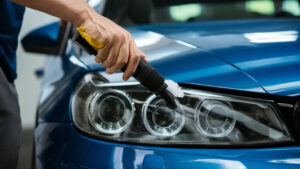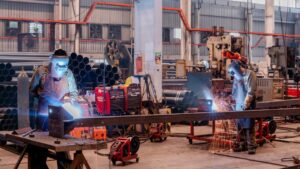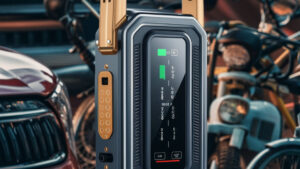A two-stage snow blower is more powerful and efficient for heavy snow compared to a single-stage model. Single-stage snow blowers are best for light snow on flat surfaces.
Choosing the right snow blower can greatly impact your winter experience. Understanding the differences between single-stage and two-stage snow blowers helps you make an informed decision. Single-stage blowers use one auger to gather and expel snow, making them ideal for light snowfall and smaller areas.
They are typically lighter and easier to maneuver. In contrast, two-stage models employ a dual auger system and an impeller, allowing them to tackle deeper, heavier snow across larger driveways or uneven terrain. This introduction highlights the key differences and sets the stage for a deeper exploration of each type’s advantages and disadvantages.
The Basics Of Snow Blowers
Single-stage snow blowers are designed for light to moderate snowfall. They use a single auger to gather and expel snow through the chute. This type is typically lighter and easier to maneuver. It works best on flat surfaces like sidewalks and driveways. However, it struggles with heavy, wet snow.
Two-stage snow blowers are more powerful and versatile. They have a dual auger system that gathers snow and sends it to a high-speed impeller. This setup allows them to handle deeper and heavier snow with ease. They are ideal for larger areas and can clear gravel surfaces without damaging the ground.

Key Differences In Mechanism
The auger in a single-stage snow blower gathers and pushes snow directly. This design is effective for light, fluffy snow. In contrast, a two-stage snow blower uses a dual auger system. The first auger collects snow, while the second auger pushes it to a high-speed impeller. This impeller efficiently throws snow out of the chute, making it suitable for heavy or wet snow.
Single-stage blowers are best for small areas and light snow. They work well on paved surfaces. Two-stage models excel in larger areas and can handle deeper snow. Their design prevents damage to gravel driveways by not clearing all the way to the ground.
Performance In Snow Conditions
Handling light snowfall is a breeze with both snow blowers. The single-stage model quickly clears light layers, making it suitable for sidewalks and driveways. It has a simple design, making it easy to maneuver.
For two-stage snow blowers, the performance excels in deeper snow. It efficiently handles light snowfall while providing more power for tougher conditions.
Managing heavy and wet snow requires different approaches. Single-stage snow blowers might struggle with wet, heavy snow. They can become clogged and require frequent clearing.
Two-stage models shine in these conditions. They feature a powerful auger and impeller, which efficiently breaks down heavy snow. This allows for easy removal without clogging.
Clearing Width And Depth
Single-stage snow blowers are designed for light to moderate snow. They can clear a width of up to 22 inches. The depth they manage is usually around 8 inches. This type is ideal for small driveways and sidewalks.
Two-stage snow blowers excel in heavy and wet snow conditions. They can handle wider paths and greater depths. A two-stage model can clear up to 30 inches wide and 12 inches deep. This makes them perfect for large driveways and commercial areas.
Single-stage models are lightweight and easy to maneuver. They work best on flat surfaces. In contrast, two-stage models are more powerful. They can tackle gravel and uneven ground with ease.
Speed And Efficiency
Single-stage snow blowers operate quickly and are lightweight. They are best for light snow and small areas. The auger gathers and throws snow in one motion, making it easy to handle. This design allows for fast operation on sidewalks and driveways.
Two-stage snow blowers provide enhanced efficiency for heavy snow. Their dual auger system offers more power and speed. This system effectively handles larger areas and deeper snow. The high-speed impeller blows snow far away, clearing paths more thoroughly.
For those facing harsh winters, two-stage models are often the better choice. They tackle challenging snow conditions with ease. Single-stage units are ideal for light snowfall and smaller spaces.
Surface Compatibility
Single-stage snow blowers work best on smooth surfaces. These models can effectively clear sidewalks and driveways. They use one auger to gather and throw snow. This design makes them lightweight and easy to maneuver.
Two-stage snow blowers are ideal for rough or gravel surfaces. They have a second impeller that helps to throw snow farther. This feature prevents gravel from getting sucked into the machine. Owners of gravel driveways often prefer two-stage models for this reason.
Choosing the right snow blower depends on the surface type. Smooth surfaces suit single-stage blowers, while rough surfaces benefit from two-stage blowers.
Maintenance And Durability
Single-stage snow blowers offer simple maintenance. Most parts are easy to access. Routine checks can be done quickly. This allows users to keep their machines in top shape.
Two-stage models, while more complex, provide long-lasting durability. They are built with stronger materials. These snow blowers can handle heavy and wet snow effectively. Proper maintenance enhances their lifespan significantly.
Both types of blowers need regular upkeep. Clean the augers and check the belts often. This ensures smooth operation and prevents future problems.
Price Considerations
Price considerations play a crucial role in choosing between a two-stage and a one-stage snow blower. Typically, two-stage models are more expensive due to their enhanced capabilities and durability. In contrast, one-stage snow blowers offer a budget-friendly option, ideal for light snow and smaller areas.
Cost Of Single-stage Snow Blowers
The cost of single-stage snow blowers is generally lower. Prices typically range from $300 to $600. These blowers are suitable for light to moderate snow. They are lighter and easier to maneuver. Many homeowners find them affordable for small driveways.
Investment In Two-stage Snow Blowers
Two-stage snow blowers are more expensive. Their prices range from $600 to $1,500. This investment is worthwhile for heavy snowfall areas. They offer more power and can handle deeper snow. Many models are designed for larger areas, making them ideal for bigger properties.
User Experience And Handling
Single-stage snow blowers are designed for easy handling. They are typically lighter and more maneuverable. This makes them great for small driveways and sidewalks. Users can easily push them around without much effort.
Many single-stage models come with user-friendly features. For instance, they often have electric starters and adjustable handles. These features enhance comfort and ease of use. This design caters to people of all ages.
Two-stage snow blowers, on the other hand, offer superior control. They handle heavier snow and larger areas more efficiently. The dual auger system provides extra power, making it easier to push through stubborn snow piles. This feature is especially helpful on gravel driveways.
Environmental Impact
Single-stage snow blowers produce higher emissions than their two-stage counterparts. They rely on smaller engines, which often burn fuel less efficiently. This can lead to increased air pollution and a larger carbon footprint. In many areas, strict regulations are in place regarding emissions from outdoor power equipment. Choosing a more efficient model can help minimize these impacts.
Two-stage models are designed with energy efficiency in mind. Their more powerful engines can handle heavier snow without using excess fuel. This means they can clear snow faster, reducing the time spent running the machine. As a result, fuel consumption is often lower. This makes them a better choice for environmentally conscious consumers.
Choosing The Right Snow Blower
Choosing the right snow blower depends on your specific needs. A two-stage snow blower is ideal for heavy or wet snow. It has a dual auger system that provides more power and efficiency. This type can handle larger areas quickly. It is also suitable for gravel driveways since it does not clean all the way to the ground.
On the other hand, a single-stage snow blower is lightweight and easy to maneuver. It works best on light, fluffy snow. This model is perfect for small driveways and sidewalks. It tends to be more affordable and requires less maintenance.
| Type | Pros | Cons |
|---|---|---|
| Two-Stage | Powerful, Fast, Good for Heavy Snow | Heavier, More Expensive |
| Single-Stage | Lightweight, Affordable, Easy to Use | Limited to Light Snow, Less Power |
Real-world User Testimonials
Users often share their experiences with one-stage and two-stage snow blowers. Many find that two-stage models excel in heavy snow. They appreciate the dual auger system for its speed and power. This system effectively clears larger areas with fewer passes.
Case studies reveal that families in snowy regions prefer two-stage blowers. They report less effort required when dealing with wet and heavy snow. A user from Minnesota stated that their two-stage blower easily handled frozen piles left by plows.
Experts recommend two-stage models for gravel driveways. These blowers don’t clean all the way to the ground, preventing gravel from entering the auger. Single-stage models work well for light snow, but may struggle with deeper accumulations.
Conclusion: The Verdict On Snow Clearing
Both one-stage and two-stage snow blowers serve different needs. A two-stage snow blower excels in heavy snow conditions. Its dual auger system provides more power for clearing large areas. The impeller allows for effective snow throwing. This model is ideal for driveways with gravel, preventing damage to the surface.
On the other hand, a one-stage snow blower is perfect for light snow. It’s lighter and easier to maneuver. This type is best suited for sidewalks and small driveways. Consider the amount of snow you typically deal with.
For those facing harsh winters, investing in a two-stage model offers greater efficiency. If snow accumulation is minimal, a one-stage blower might suffice. Evaluate your specific needs to make the right choice.
Frequently Asked Questions
Which Is Better, A 1 Stage Or 2 Stage Snow Blower?
A two-stage snow blower is generally better for heavy, wet snow and larger areas. It offers more power and efficiency than a single-stage model. Single-stage units work well for light snow on flat surfaces and are typically more affordable. Choose based on your specific snow removal needs.
Why Is A Two-stage Snow Blower Better?
A two-stage snow blower is better because it efficiently handles heavy and wet snow. Its dual auger system offers increased power and speed. This design allows for deeper penetration into stubborn snow piles, making clearing larger areas easier. It also protects gravel surfaces by not scraping down to the ground.
Which Stage Snow Blower Is Best?
The best snow blower depends on your needs. Two-stage snow blowers excel in heavy snow and uneven surfaces. They handle deeper snow and larger areas efficiently. For light snow on flat surfaces, a single-stage blower suffices. Assess your snow conditions before choosing the right model for you.
How Deep Of Snow Can A Single Stage Snow Blower Handle?
A single-stage snow blower can handle snow depths up to 8 inches. It works best with light, fluffy snow. For deeper or heavier snow, consider a two-stage model for better performance.
Conclusion
Choosing between a 1-stage and a 2-stage snow blower ultimately depends on your specific needs. For light snowfall and small driveways, a 1-stage model may suffice. Conversely, a 2-stage snow blower excels in heavy, wet snow and larger areas. Assess your snow conditions and budget to make an informed decision.








